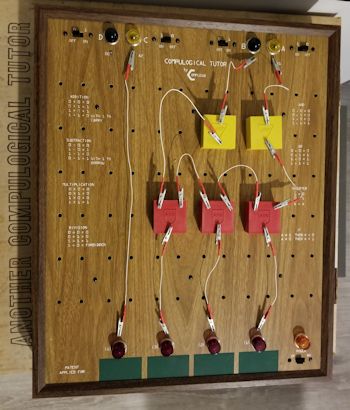TSC BASIC for SWTPc 6800
SHARE |
|
  TSC BASIC for SWTPc 6800
TSC BASIC for SWTPc 6800 |
by Bill Degnan - 05/09/2011 18:34 |
|
It took more than three hours entering in almost 4Kb worth of 2-digit HEX
instructions into my teletype, and a good 20 minutes or so to punch a tape, but I was successfully able to save TSC BASIC on my SWPTc 6800 to papertape. And the freakin thing actually worked the first time. The documentation for TSC BASIC told me how to modify the program for my system, etc. Saving me a lot of debugging time. There is a write up about TSC BASIC in the January 1978 Kilobaud (comparing 4 6800 CPU BASICs), and fortunately I found a copy of the papertape program here: http://www.swtpc.com/mho...asic/TSC_MicroBasic.htm I downloaded the papertape program as a text file and then parsed the data in MS Excel. This way I could separate the data from the checksum at the end of each line of papertape, and to see the address value. There is a point when entering in that much data that you kind of become one with the machine. I was entering instructions in synch with the teletype output of the memory values, etc. Kind of crazy I guess. Kind of Zen too. I will be brining this to VCF East as part of my exhibit. A Tale of Four BASICs - Which one for your 6800? - Good article comparing TSC BASIC with three others. Reply |
|
  Load TSC BASIC on SWTPc 6800 from Laptop
Load TSC BASIC on SWTPc 6800 from Laptop |
by Bill Degnan - 06/04/2013 15:12 |
|
Here is how to load TSC BASIC onto your SWTPc 6800 from your laptop/desktop without disk drive, cassette or teletype, and for some reason you're having trouble sending a papertape image the normal way (papertape image link below). With this method you can slow down down enough to watch the download and use the log capture function of the termainal program to locate a RAM location.
1. You need a working SWTPC 6800 computer with 8K RAM set to 0000 - 3FFF, and a MP-S serial card set for RS232 communications. 2. You need a copy of TeraTerm or similar terminal program installed on your laptop. Also download the specially-prepared TSC BASIC to your laptop. This version is made for a system with MIKBUG or SWTBUG monitor running and an MP-S serial card, only. 3. The SWTPC 6800 with MIKBUG or SWTBUG should be able to communicate with your laptop using the terminal program. From the prompt you should be able to check and edit memory (M 0000), etc. without problems. 4. Set your terminal program to use N/8/1. Baud rate is not important as long as you're able to communicate with your SWTPc. Change the character delay time setting used by your terminal serial port to at least 100 msec, so you can watch for errors while TSC BASIC is being downloaded. You can then adjust more / less of a delay until optimal for you. 5. With your terminal program displaying the MIKBUG or SWTBUG prompt, send the file TSCBASIC.txt. Leave binary UNchecked. 6. Watch as the file is downloaded. Basically what you're doing is simulating the keystrokes entered into the monitor program as if you were typing in TSC BASIC by hand incredibly fast. The character delay is necessary to allow the computer key input buffer to keep up with the simulated keystrokes. 7. When complete, the display will freeze waiting for input. Hit enter on the keyboard to return to the monitor prompt if not already there. 8. Type the command J 0100 [Enter] The computer should respond with the " > " prompt. (I changed the code to use a different prompt than the default ! mark). You can now enter BASIC commands. You can use also use this method to download BASIC programs. You can save BASIC programs by turning on the log capture feature in your terminal software and then LISTing your code. In addition to the file link above, you can also download a copy of the TSC Manual, and MP-S adapted S1 tape file here. Reply |
|
Resources:

Popular Topics and FAQs
Past Issues:
Before we switched over to a blog format, past page archives here:
Vintage Computer Festival East 3.0 June 2006
Commodore B Series Prototypes July 2006
VOLSCAN - The first desktop computer with a GUI? Oct 2006
ROBOTS! - Will Robots Take Over? Nov 2006
Magnavox Mystery - a Computer, or? Jan 2007
The 1973 Williams Paddle Ball Arcade Computer Game Feb 2007
The Sperry UNIVAC 1219 Military Computer May 2007
VCF East 2007 - PET 30th Anniversary June/July 2007
The Electronic Brain August 2007
Community Memory and The People's Computer Company October 2007
Charles Babbage's Calculating Machine December 2007
Vintage Computing - A 1983 Perspective February 2008
Laptops and Portables May 2008
From Giant Brains to Hobby Computers - 1957 to 1977 August 2008
Historic Computer Magazines November 2008
World's Smallest Electronic Brain - Simon (1950) December 2008 - Feb 2009
Free Program Listings Spring 2009
Computer Music Summer 2009
Popular Electronics Jan/Feb 1975 - Altair 8800 Fall 2009
Early Microcomputer Mass Storage Summer 2010
Compulogical Tutor 2

This image was selected at random from the archive. Click image for more photos and files from this set.